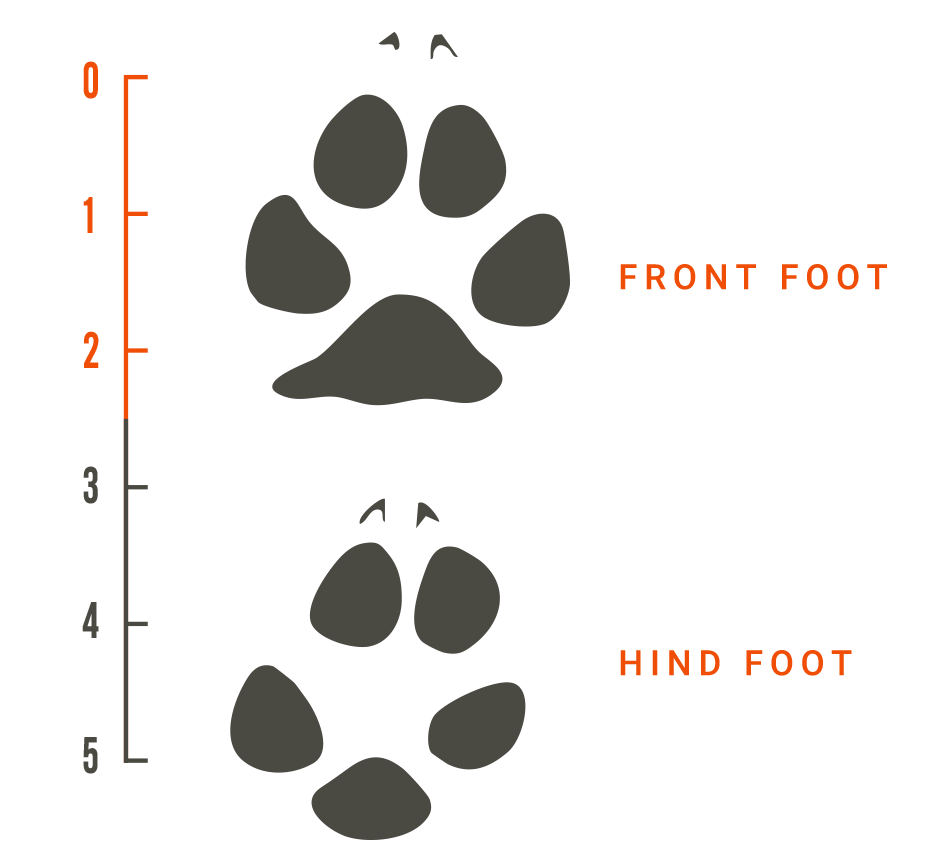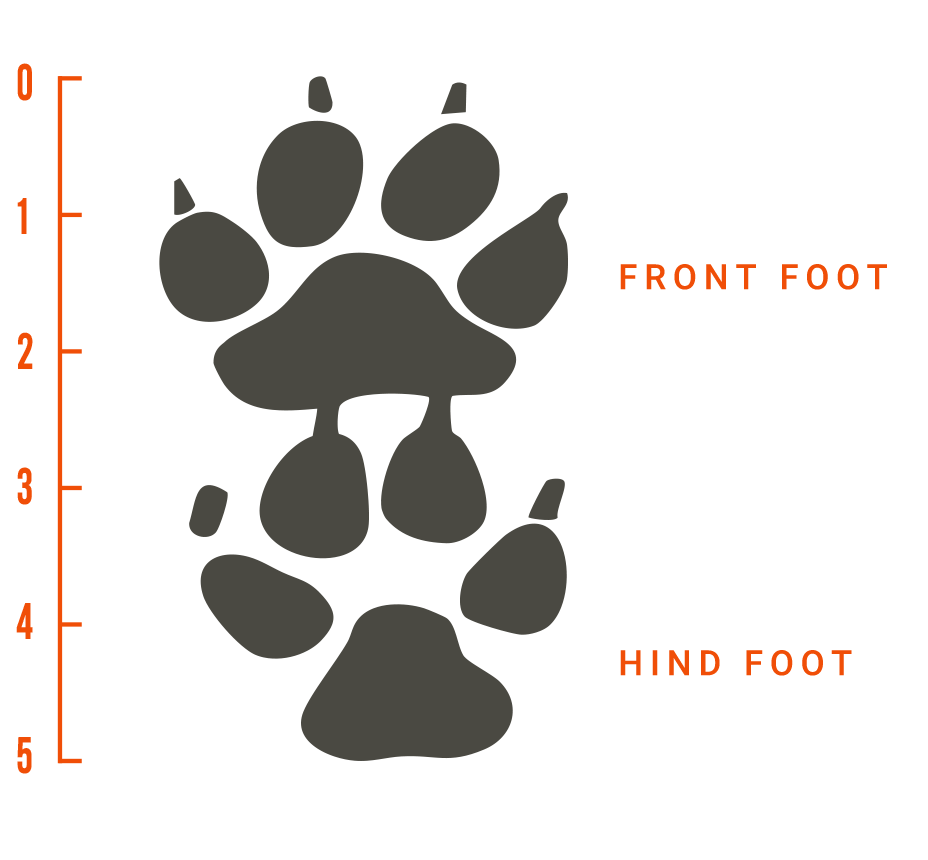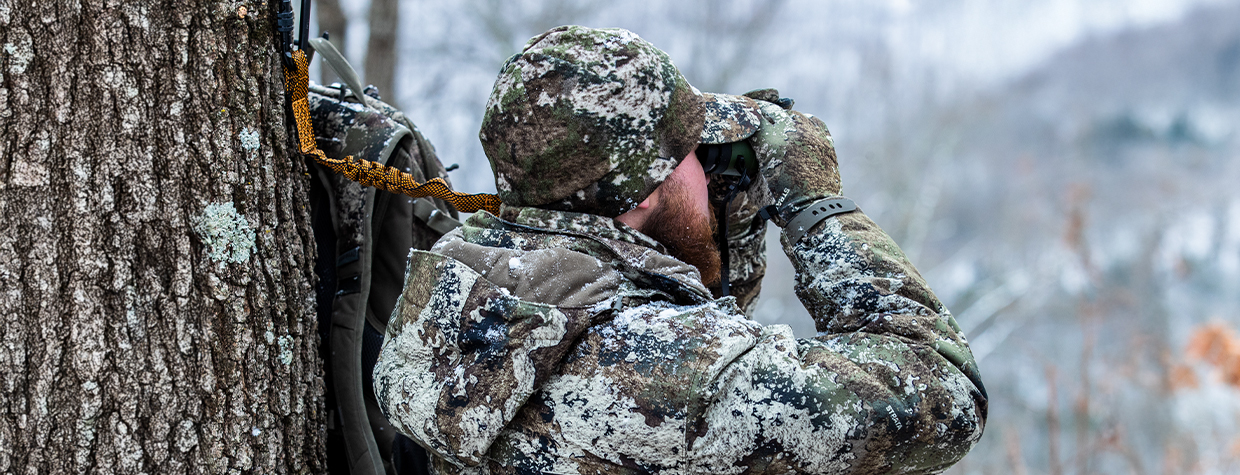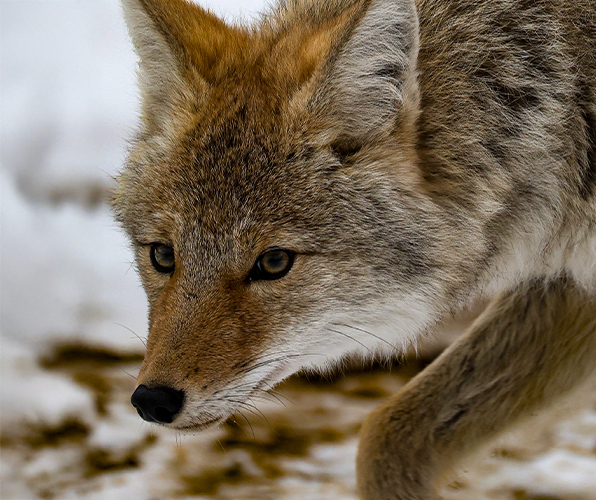Coyote Hunt Techniques

How to Identify Coyote Tracks, Gaits & Scats
Coyotes are one of the most widespread canine species in all North America. Since they are intelligent and adaptable in all habitat types, it is natural, their signs and tracks are found everywhere. While it can be slightly tricky to recognize coyote tracks and signs from a domestic dog, under close observation, one can differentiate it.
How to Differentiate Coyote Tracks vs Domestic Dog Tracks
Coyote Tracks

Coyote Tracks
- Four toes generally show
- Footprints are oval-shaped and measure approximately 2.5 inches
- Claws are sharp, point forward & inward and thin
- Claws often show, but not always
- Leading two claws mostly point inward
- Toes point forward, little splay
- Front tracks are larger than the hind tracks
- Negative space is shaped like an X or a star
- Outer toes are slightly larger than the inner toes
- Inner toes on the hind legs are larger than the other toes
- Trails neater with less wasted energy
- Toes compact in track, minimal splay
- Foot pad is close to triangle shape
- Slight lead toes/claw differentiates left from right feet
Domestic Dog Tracks

Domestic Dog Tracks
- Four toes usually show
- Claws are generally blunt and splay outward
- Claws often show, but not always
- Front tracks are often larger than hind tracks
- Toes 2 & 5 generally spay outward and are more circular than oblong
- Toes and heel pad may register at the same depth
- Outer toes can be outside or behind inner toes
- Dog breeds influence the shape of the tracks
- Negative space is shaped either like an X or H
- Trails are playful and meandering
- Sloppy indirect register
Identifying Coyote Gaits
- Coyotes exercise walking, trotting, galloping, and loping gaits
- One of their favoured gaits is an overstep trot, where they leave a line of tracks that are straight and narrow. Their step lengths between the tracks measure from 15 to 22 inches
- In a slow trot, each hind track has landed slightly behind the front track while on an overstep trop, their front and hind feet land closely and on the same side of the body
Identifying Coyote Scats
- Coyote’s scat is usually less than an inch in diameter and has a tubular and tapered end
- The scats are lighter and brighter in summer as they eat more vegetables while it’s darker in winter and contains more bone fragments and fur
- While their scat is like a domestic dog’s, coyotes is filled with bones or fur
Coyotes try to communicate through their scat by leaving them in prominent places like the middle of trails or near the borders of their territories to mark their presence.
Scent Control Tips for Coyote Hunting
Coyotes can sniff out human scent from over a mile. They have an average of 220 million receptors in its nose while humans only have five million.
Many animals rely on scent as they might not be able to see you. Often animals are attracted by a familiar scent. When you call in an animal and they approach you from downwind, but do not smell the critter that they think they hear, they are often on alert and curious.
Hunters are aware of using scent control for whitetail deer hunting, and similarly, the same principles apply for various species including coyotes and other predators.
Using Scent Control with Your Calls
Place your calls at distance and control them remotely. Using electronic calls will help you for several reasons:
- You can avoid coyotes looking right at you when you place your call away.
- When you have your call a ways away, coyotes will be downwind of the call and not downwind of our position. This is an opportunity to use scents as the coyote is downwind of the call and will be convinced that the critter/rabbit is in distress. Often this works well and brings in a coyote within your range.
- Many calls come with or offer decoy as an added accessory, so you can lure coyotes even closer by providing added realism through motion.
Note: Animals in high pressured areas are often more cautious of calls. In situations such as these, scents really help. Effective scent control helps in bringing predators into target range.
How Wind Affects Scents During Hunting
- Paying attention to wind direction is vital for any hunt. If using an attractant scent, ensure to position it where it is not blowing in the same direction as your downwind side.
- If you are using a cover scent, place it next to you. This helps in masking your scent and gives you a little extra time to get a shot.
How to Scout Coyotes for Hunting
Coyotes have sharp senses and wild instincts. You must be a step ahead when it comes to scouting for them. Look for chicken and turkey farms, timber-lined agricultural fields, and open areas that have cattle feed yards or pastures.
- Plan Your Approach: Keep the wind in your face, use the terrain to your advantage, travel slowly and camo yourself to blend into the surroundings.
- Hunting Location: Where you sit matters. Always choose an elevated location to help you see long distances. Access vantage points in stealth and circle a hill, if necessary, rather than roving across the top. In country side, coyotes seek out gullies, grassy depressions, brushy fencerows, and swampy areas.
Place an e-caller in an area that offers a coyote the quickest and the easiest path to the call. Like turkey, coyotes have an ability to locate the sound/call and will come right to the source if it is easy to locate.
Note: Coyotes circle downwind of its intended prey. However, if your call is in their direct line of sight, they will likely come right in and give you an easy shot.
If you are seeking coyotes in rural areas, here are a few tips:
- Seek Permission: If hunting on private lands, seek permission from the landowners. Try to get intel from the landowners if possible. This will give you the best chance to call in a coyote.
- Listen Actively: At dawn or dusk, take a drive around the area, pay attention to spots with plenty of cover (land with woods, brush, and hills). Keep your windows down, turn off the radio, occasionally, turn off your engine to listen more carefully. When you hear a coyote call, note your location on the map.
- Search: Look for coyote scouts and tracks in the mud or snow, droppings and any evidence left behind from a kill.
- Record Your Observations: Throughout the scouting period, make notes for a successful hunt.
Techniques for Coyote Hunting
Times when coyotes are reluctant to respond to your calls, moving to other techniques like spot & stalk, or snaring can help you find your targets.

Spot and Stalk Hunting Technique
If you are seeking coyotes in rural areas, here are a few tips:
Spot and stalk helps you cover more ground with your eyes, and helps you spot a coyote from afar. This hunting technique gives a chance to judge your target from a distance before you are obligated to make the decision on whether to take it down.
Starting Point: Coyotes cruise around for mating and hunting. In between their jaunts, they will stop to rest in the open.
Instead of looking for a large target, look for smalls balls of fur to find your game.
Activate Stealth Mode: Stay unnoticed and hidden while stalking for coyotes. Ease up to the rises or peer over the top of grass. Ensure you have a backdrop to avoid any silhouettes. Same as your calling setup, have an elevation like canyon rims, or ridges to oversee coyote movements.
Be Prepared with Your Equipment: Having the right kind of optics will play a key role in finding your target for the day. Here are a few options for your coyote hunt:


